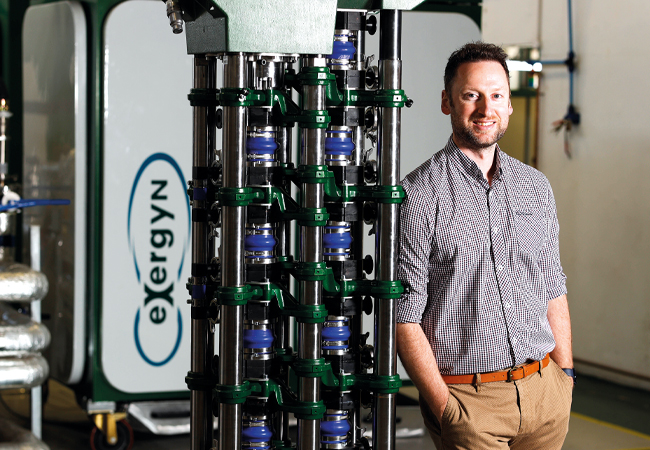
CIBSE’s new research manager, Zoe De Grussa (with the mic), chaired the session on overheating
The rapidly warming climate in the UK is putting the health and comfort of building occupants at increasing risk. A number of CIBSE projects are focusing on measuring the resilience of buildings and determining what mitigation measures must be taken.
At last month’s Futurebuild conference at London’s ExCeL, CIBSE hosted a session on overheating in the built environment. Four speakers, on a panel chaired by CIBSE’s new research manager, Zoe De Grussa, covered overheating in care homes, the impact of new CIBSE Weather Files, and upcoming changes to CIBSE’s TM59: Design methodology for assessing overheating in homes.
Professor Rajat Gupta, from Oxford Brookes University, and Professor Anna Mavrogianni, from UCL Bartlett School Environment, Energy and Resources, shared findings from the ClimaCare: Climate resilience in care homes project (bit.ly/CCare2020).
After extensive monitoring of nearly 50 care homes in the UK, the project team found extensive overheating that was ‘pronounced and long’, according to co-investigator Gupta. He said that data from summer 2022 showed temperature peaks into the high 30s and median indoor temperatures of around 25°C. Temperatures during occupied hours in London care homes were 1.5 to 2.1°C higher than the rest of the country, he added.
Occupier surveys found that staff were much more sensitive to heat, with respondents saying they felt hot from 28-29°C, compared with residents, who said they felt hot when temperatures reached 32°C.
The project looked at interventions to reduce overheating and their effectiveness was quantified through building performance simulations, said Mavrogianni. It found that passive measures could suffice in care homes in the 2020s, when modelling predicted an increase of internal temperatures by 2°C. By 2050, however, air conditioning would be required to maintain thermal comfort, as modelling suggested 4°C temperature increases in care homes, said Mavrogianni, who added that – in a warmer climate – active cooling measures should be combined with passive ones to minimise cooling loads.
Construction age was a key indicator of overheating risk, with staff and residents in older, heavyweight buildings less likely to overheat in summer than those in modern, lightweight buildings, said Mavrogianni.
Hailun Xie, environmental data scientist with CIBSE and the University of Exeter, discussed the new CIBSE weather files, which are based on the latest Met Office climate data predications, UKCP18, and will be published later this year. Two versions of the weather files have been created using UKCP18, with the second version aiming to better emulate extreme weather events.
Construction age was a key indicator of risk, with staff and residents in older, heavyweight buildings less likely to overheat in summer
Xie said modelling of a case-study flat in London found that overheating risks could increase significantly in future, with more frequent and intense heat events. The CIBSE weather files would be grouped by areas of similar climate, rather than geographical proximity, added Xie, who said a digital tool is being developed to improve weather data accessibility and allow long-term planning of future building energy systems.
Inkling founder Susie Diamond gave an update on TM59, which was adopted into Part O of the Building Regulations in 2021. She said the latest version would hopefully be included in the Future Homes Standard, due in 2025.
TM59 is a dynamic thermal modelling methodology that designers can use to meet Approved Document O, which requires mitigation against overheating. To comply with TM59, criteria must be met. Currently, temperatures in bedrooms from 10 pm to 7 am shall not exceed 26°C for more than 1% of annual hours. The proposed update is that the overheating criteria will be based on the number of summer nights where bedrooms exceed a night-time mean threshold temperature, and temperatures from 26°C to 28°C are being tested.
Other proposals are a new gain profile for home offices, the modelling of ceiling fans (with an algorithm based on the ASHRAE standard), and a night-time bedroom window opening profile. The team is also looking at allowing the modelling of open internal doors at night (but not bedroom doors).
Diamond said TM59 would be published in the summer and updated with the latest weather files. She hoped changes would be adopted by Part O.
For more information on TM59 and weather files, visit: bit.ly/CJTM59 and
www.cibse.org/weatherdata




